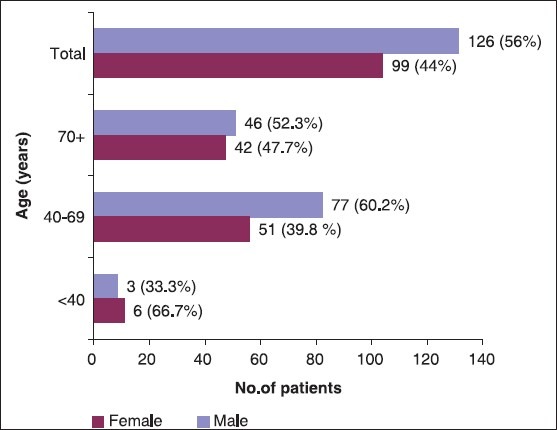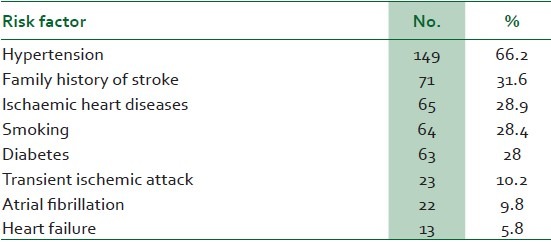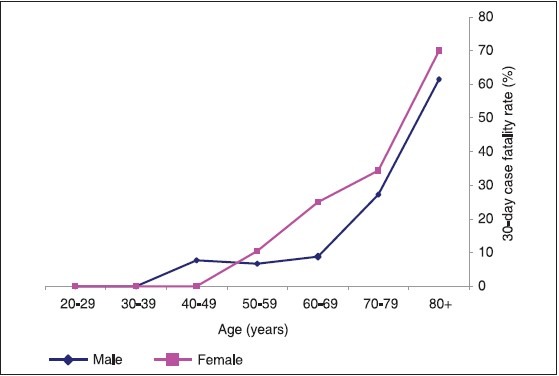Abstract
Background:
The aim of this hospital-based study is to determine the types, the frequency of risk factors and the 30-day case fatality of first-ever stroke in Basrah, Iraq.
Materials and Methods:
This was a hospital-based prospective study between January 2008 and July 2008 in Basrah, Iraq. Two hundred twenty-five (225) patients, who were admitted for first-ever stroke to the four major hospitals in Basrah, were interviewed and followed up for 30 days. Risk factors studied were smoking, history of diabetes mellitus, hypertension, atrial fibrillation, ischaemic heart diseases and transient ischaemic attack.
Results:
The mean age of the studied subjects was 63.8 ± 12.3 years. Males constituted 56% of cases. Clinical types of stroke were ischaemic stroke (83.6%), intracerebral haemorrhage (16%) and subarachnoid haemorrhage (0.4%). The prevalence of risk factors was; hypertension (66.2%), family history of stroke (31.6%), ischaemic heart diseases (28.9%), smoking (28.4%), diabetes mellitus (28%), transient ischaemic attack (10.2%), atrial fibrillation (9.8%) and heart failure (5.8%). The 30-day case fatality rate was 22.7%.
Conclusions:
Ischaemic stroke was the highly prevalent type. Hypertension, family history of stroke, ischaemic heart diseases, smoking and diabetes mellitus were the major risk factors of first ever stroke in Basrah. The 30-day case fatality rate of stroke in Basrah was nearly similar to that in western countries, but higher than that reported in the neighbouring Arab countries. Early detection of modifiable risk factors that can prevent stroke or at least minimise its complications is highly recommended.
Keywords: Basrah, case fatality, stroke
INTRODUCTION
Stroke is a major health problem worldwide because it is a common cause of mortality and a leading cause of adult long-term disability, in addition to its socioeconomic burden for society and its great impact on the health system.1 According to the World Health Organisation estimates, 15 million people each year suffer stroke, 5 million are left permanently disabled and 5.7 million deaths from stroke worldwide occurred in the year 2005.2 Stroke is responsible for 10-20% of all deaths in industrialised countries and almost 90% of the deaths attributed to stroke are among people aged over 65 years.3 Two-thirds of global stroke's deaths occurred in people living in developing countries.4 The future burden of stroke is likely to increase in developing countries because of the combined challenges of demographic shift i.e. aging of the population, and increasing exposure to risk factors such as hypertension, diabetes mellitus and lifestyle changes.5
Despite this, there have not been many epidemiological studies on stroke in Iraq.6 No study on stroke epidemiology or mortality had been conducted in Basrah. Therefore, this study was conducted with the aim of determining the distribution of first-ever stroke risk factors, types, and to estimate its 30-day case fatality rate in Basrah.
PATIENTS AND METHODS
This hospital-based prospective study was conducted from January 2008 to July 2008 in Basrah, Iraq.
Two hundred twenty-five (225) patients, who were admitted for first-ever stroke to the medical wards in four major multispecialty hospitals in Basrah, were interviewed during hospitalisation by one of the authors who visited those hospitals every other day, clinically examined, and followed up until 30 days post stroke onset.
This study was approved by the Ethics and Human Research Committee of College of Medicine, Basrah University.
Statistical analysis
All statistical analyses were done using Statistical Package for Social Sciences (SPSS) 15. To compare frequencies or means, X2 and t-test were used, respectively. A P-value of <0.05 was considered significant.
RESULTS
The total number of the enrolled patients was 225 patients. The mean age of the patients was 63.8 ± 12.3 years. More than two-thirds (68.4%) of them were aged 60 years and more. Males constitute 56% with a male:female ratio of 1.27:1. However, females outnumbered males in the younger age group (<40 years) [Figure 1].
Figure 1.

Age and sex distribution of the stroke patients
Ischaemic stroke constituted the majority of cases 188 (83.6%), while intracerebral haemorrhage was reported in 36 patients (16%). Subarachnoid haemorrhage was rare; it was reported in only one patient (0.4%).
As shown in [Table 1], the most common prevalent risk factor was hypertension which was found in 66.2%, whereas the least common prevalent risk factor was heart failure (5.8%).
Table 1.
Distribution of risk factors among patients with stroke

Of the 225 patients (126 males and 99 females) who were admitted to the hospitals, 51 (23 males and 28 females) died within 30 days post stroke event resulting in a 30-day case fatality rate of 22.7%, (18.3% for males and 28.3% for females).
The 30-day case fatality rate for both men and women increased with increasing age, but men stroke mortality exceeds that of women only in the younger age groups (less than 49 years of age) [Figure 2].
Figure 2.

Age and sex specific 30-day case fatality rate
DISCUSSION
The mean age of stroke patients in this study was 63.8 ± 12.3 years, and more than 68% of them were aged 60 years and above, which is in agreement with that reported in many Asian and developing countries,7,11,15,16,27 but it was about one decade lower than that reported in Western countries.9,13
This study agrees with many studies in finding a male preponderance (a male: Female ratio of 1.27:1).5,20,26,27 It was reported that Stroke incidence rates are 1.25 times greater in men, but because women tend to live longer than men, more women than men die of stroke each year.28
In this study, ischaemic stroke forms 83.6% of all stroke cases. It is in agreement with other studies which stated that much of the public health stroke burden is attributed to ischaemic stroke which is accounting for 75-85% of all stroke cases.29 Also, the results were similar to that reported from Qatar,14 Mumbai (India)27 and Saudi Arabia.7 The higher rate of cerebral ischaemia, which was reported in this study, may be explained by that most Iraqi people are adopting Western lifestyle and dietary habits, including increased fat intake, cigarette smoking and decreased physical activity. These changes may have resulted in increased prevalence of obesity, hypertension, diabetes and cardiac diseases that contribute to the development of ischaemic stroke, or that haemorrhagic stroke is usually more severe and associated with higher and earlier mortality in comparison with ischaemic type, especially in the first 3 days post ictus,27,30 so patients might die before reaching hospitals or soon after arrival.
As with other studies, this study has considered stroke as a single disease. The determinants of subtypes of stroke were found to be different in strength and direction of association from one subtype to another,31 therefore, such subtypes have to be analysed separately. The most prevalent risk factors in this study were; hypertension, family history of stroke, pre-existing ischaemic diseases, smoking and diabetes, a result which had been found in other studies.31
The 30-day case fatality rate of stroke differs in different countries in the world [Table 2]. It was reported that the 30-day case fatality rates for all strokes worldwide average 22.9 %, and range from 16% in Shiga (Japan)9 to 34.8% in Georgia24 [Table 2].
Table 2.
30-day case fatality rate in different countries

In this study, the 30-day case fatality rate of stroke was 22.7% which was nearly similar to that reported in some Asian and western countries, Pakistan,16 Ukraine,20 Chile,23 Sweden,8 and Italy,22 but it was lower than that reported for some Eastern European countries such as, Russia,10 Georgia,24 Bulgaria21 and some Asian countries such as Iran.25 It was higher than that reported in some Arab countries such as Saudi Arabia,11 Qatar14 and Kuwait.17 Such great variation in 30-day case fatality rates of stroke between countries could not be accounted for by chance alone. The possible explanation may be due to the differences in management of cases or and lack of specialised stroke centres in some countries, or due to differences in severity of cases in different countries taking in account the relative high risk factors in stroke patients in certain countries compared with others. Also, the differences in hospitalisation rate and differences in case ascertainment between the studies may influence the case fatality rate.
Women experienced a high 30-day case fatality rate than men (28.3% for females versus 18.3% for males) particularly in older age groups — a result that had been reported in many other studies.32,33
Our results [Figure 2] showed that the age and sex specific 30-day case fatality rate increased with increasing age in both men and women — a result that had been confirmed by other studies. For each successive 10 years after age 55, the stroke rate more than doubles in both men and women.34,35
Although women with stroke outnumbered men in the early age groups, they showed low case fatality rates than men in these age groups. Factors such as oral contraceptive use, pregnancy, and sex difference in distribution of other risk factors may contribute to the increased risk of stroke in young women. The longer life-expectancy of women and the earlier cardiac-related deaths of men with coronary heart diseases may contribute to the relatively greater risk of stroke mortality in older women.16,33
There are several limitations for this study. First; serum cholesterol measurement was not included in this study because such investigation had not been done in the hospitals for all the studied patients. The absence of analysis of such variable may have influenced the results. However, a controversy about the association between cholesterol and stroke was reported.36 Second, this was a hospital-based study. Thus, patients with very minor deficits (and not admitted), those who refused admission, those who died before admission, and those who were admitted to private hospitals were not included. Despite these limitations, this study provides some information about first-ever stroke in Basrah and the results are comparable with that in other countries.
In conclusion, stroke was more common with increasing age particularly over the age of 6o years. More men suffer from stroke, but women experienced higher case fatality than men. Ischaemic stroke was the most common type. The overall distribution of stroke types was similar to that reported in most Asian and Arab countries. On the other hand, the 30-day case fatality rate of stroke was nearly similar to that in western countries, but higher than that reported in the neighbouring Arab countries and lower than that in the Eastern European countries. Hypertension, family history of stroke, diabetes mellitus, smoking and cardiac diseases were the main risk factors of stroke in Basrah. Many of these factors are modifiable; therefore, early detection of these factors can prevent stroke or at least minimise its complications. Further studies, particularly community-based, are needed to estimate the incidence of stroke in Iraq.
ACKNOWLEDGMENTS
The authors would like to thank the personnel of the hospitals in which the study was conducted for their kind help and cooperation. Our deep gratitude also goes to our study subjects and their families who took their time to give us all the relevant information for the study.
Footnotes
Source of Support: Nil
Conflict of Interest: None declared.
REFERENCES
- 1.Carandang R, Seshadri S, Beiser A, Kelly-Hayes M, Kase CS, Kannel WB, et al. Trends in incidence, lifetime risk, severity, and 30-day mortality of stroke over the past 50 years. JAMA. 2006;296:2939–46. doi: 10.1001/jama.296.24.2939. [DOI] [PubMed] [Google Scholar]
- 2.World Health Organization. WHO STEPS stroke manual: The WHO Stepwise approach to stroke surveillance. Geneva: WHO; 2006. [Google Scholar]
- 3.Kwan J. Clinical epidemiology of stroke. CME J Geriatr Med. 2001;3:94–8. [Google Scholar]
- 4.Truelesn T, Bonita R, Jamrozik K. Surveillance of stroke: A global perspective. Int J Epidemiol. 2001;30:S11–6. doi: 10.1093/ije/30.suppl_1.s11. [DOI] [PubMed] [Google Scholar]
- 5.Sulaiman NF, Khalil AI, Al-Mahdawi A. Evaluation of stroke patients. Iraq J Comm Med. 2002;15:64–8. [Google Scholar]
- 6.Jawad AA, Abdul-Kareem AM, Al-Tawil WG. A cross-sectional study of series of stroke cases. Iraq Postgrad Med J. 2003;2:218–22. [Google Scholar]
- 7.El-Sayed MM, Adeuja AO, El-Nahrawy E, Olaish MA. Characteristics of stroke in Hofuf, Saudi Arabia. Ann Saudi Med. 1999;19:27–31. doi: 10.5144/0256-4947.1999.27. [DOI] [PubMed] [Google Scholar]
- 8.Terent A. Trends in stroke incidence and 10-year survival in Söderhamn, Sweden, 1975-2001. Stroke. 2003;34:1353–8. doi: 10.1161/01.STR.0000074038.71700.1C. [DOI] [PubMed] [Google Scholar]
- 9.Kita Y, Okayama A, Ueshima H, Wada M, Nozaki A, Choudhury SR, et al. Stroke incidence and case fatality in Shiga, Japan 1989-1993. Int J Epidemiol. 1999;28:1059–65. doi: 10.1093/ije/28.6.1059. [DOI] [PubMed] [Google Scholar]
- 10.Feigin VL, Wiebers DO, Whisnant JP, O’Fallon WM. Stroke incidence and 30-day case-fatality rates in Novosibirsk, Russia, 1982 through 1992. Stroke. 1995;26:924–9. doi: 10.1161/01.str.26.6.924. [DOI] [PubMed] [Google Scholar]
- 11.al-Rajeh S, Awada A, Niazi G, Larbi E. Stroke in a Saudi Arabian National Guard Community. Analysis of 500 consecutive cases from a population-based hospital. Stroke. 1993;24:1635–9. doi: 10.1161/01.str.24.11.1635. [DOI] [PubMed] [Google Scholar]
- 12.Ellekjaer H, Holmen J, Indredavik B, Terent A. Epidemiology of stroke in Innherred, Norway, 1994 to 1996. Incidence and 30-day case-fatality rate. Stroke. 1997;28:2180–4. doi: 10.1161/01.str.28.11.2180. [DOI] [PubMed] [Google Scholar]
- 13.Wolfe CD, Giroud M, Kolominsky-Rabas P, Dunadas R, Lemesle M, Heuschmann P, et al. Variation in stroke incidence and survival in 3 areas of Europe. European Registries of Stroke (EROS) Collaboration. Stroke. 2000;31:2074–9. doi: 10.1161/01.str.31.9.2074. [DOI] [PubMed] [Google Scholar]
- 14.Hamad A, Hamad A, Sokrab TE, Momeni S, Mesraoua B, Lingren A. Stroke in Qatar: A one-year, hospital-based study. J Stroke Cerebrovasc Dis. 2001;10:236–41. doi: 10.1053/jscd.2001.30382. [DOI] [PubMed] [Google Scholar]
- 15.Cheung CM, Tsoi TH, Hon SF, Au-Yeung M, Shiu KL, Lee CN, et al. Outcomes after first-ever stroke. Honk Kong Med J. 2007;13:95–9. [PubMed] [Google Scholar]
- 16.Khan SN, Vohra EA. Risk factors for stroke: A hospital based study. Pak J Med Sci. 2007;23:17–22. [Google Scholar]
- 17.Al-Shammri S, Shahid Z, Ghali A, Mehndiratta MM, Swaminathan TR, Ghadha G, et al. Risk factors, subtypes and outcome of ischaemic stroke in Kuwait: A hospital-based study. Med Princ Pract. 2003;12:218–23. doi: 10.1159/000072287. [DOI] [PubMed] [Google Scholar]
- 18.Ong TZ, Raymond AA. Risk factors for stroke and predictors of one-month mortality. Singapore Med J. 2002;43:517–21. [PubMed] [Google Scholar]
- 19.Appelros P, Nydevik I, Viitanen M. Poor outcome after First-Ever stroke: Predictors for death, dependency, and recurrent stroke within the first year. Stroke. 2003;34:122–6. doi: 10.1161/01.str.0000047852.05842.3c. [DOI] [PubMed] [Google Scholar]
- 20.Mihalka L, Smolanka V, Bulecza B, Mulesa S, Bereczki D. A population study of stroke in West Ukraine: Incidence, stroke services, and 30-day case fatality. Stroke. 2001;32:2227–31. doi: 10.1161/hs1001.097107. [DOI] [PubMed] [Google Scholar]
- 21.Powels J, Kirov P, Feschieva N, Stanoev M, Atanasava V. Stroke in urban and rural populations in north-east Bulgaria: incidence and case fatality findings from a ‘hot pursuit’ study. BMC Public Health. 2002;2:24. doi: 10.1186/1471-2458-2-24. [DOI] [PMC free article] [PubMed] [Google Scholar]
- 22.Musolino R, La Spina P, Serra S, Postorino P, Calabro S, Savica R, et al. First-ever stroke incidence and 30-day fatality in the Sicilian Aeolian archipelago, Italy. Stroke. 2005;36:2738–41. doi: 10.1161/01.STR.0000190907.88846.df. [DOI] [PubMed] [Google Scholar]
- 23.Lavados PM, Sacks C, Prina L, Escobar A, Tossi C, Araya F, et al. Incidence, 30-day case fatality rate, and prognosis of stroke in Iquiqe, Chile: A 2-year community-based prospective study (PISCIS Project) Lancet. 2005;365:2206–15. doi: 10.1016/S0140-6736(05)66779-7. [DOI] [PubMed] [Google Scholar]
- 24.Tsiskaridze A, Djibuti M, van Melle G, Lomidze G, Apridinidze S, Gauarashvili I, et al. Stroke incidence and 30-day case fatality in a Suburb of Tbilisi. Stroke. 2004;35:2523–8. doi: 10.1161/01.STR.0000144683.96048.98. [DOI] [PubMed] [Google Scholar]
- 25.Oveisghran S, Sarrafzadegan N, Shirani S, Hosseini S, Hasanzadeh P, Khosravi A. Stroke in Isfahan, Iran: Hospital Admission and 28-day Case Fatality Rate. Cerebrovasc Dis. 2007;24:495–9. doi: 10.1159/000110418. [DOI] [PubMed] [Google Scholar]
- 26.Minelli C, Fen LF, Minelli DP. Stroke incidence, prognosis, 30-day, and 1-year fatality rates in Matao, Brazil: A population-based prospective study. Stroke. 2007;38:2906–11. doi: 10.1161/STROKEAHA.107.484139. [DOI] [PubMed] [Google Scholar]
- 27.Dalal PM, Bhattacharjee M, Vairale J, Bhat P. Mumbai Stroke Registry (2005-2006) Surveillance using WHO Steps Stroke Instrument--Challenges and Opportunities. J Assoc Physicians India. 2008;56:675–80. [PubMed] [Google Scholar]
- 28.Wong KS. Risk factors for early death in acute ischaemic stroke and intracerebral haemorrhage: A prospective hospital-based study in Asia. Asian Acute Stroke Advisory Panel. Stroke. 1999;30:2326–30. doi: 10.1161/01.str.30.11.2326. [DOI] [PubMed] [Google Scholar]
- 29.Sacco RL, Benjamin EJ, Broderick JP, Dyken M, Easton JD, Feinberg WM, et al. American Heart Association Prevention Conference. IV. Prevention and Rehabilitation of Stroke Risk factors. Stroke. 1997;26:1507–17. doi: 10.1161/01.str.28.7.1507. [DOI] [PubMed] [Google Scholar]
- 30.Thrift AG, Dewey HM, Macdonnell RA, McNeil JJ, Donnan GA. Incidence of the stroke subtypes: Initial findings from the North East Melbourne Stroke Incidence Study (NEMESIS) Stroke. 2001;32:1732–8. doi: 10.1161/01.str.32.8.1732. [DOI] [PubMed] [Google Scholar]
- 31.Rodgers H, Greenway J, Davies T, Wood R, Steen N, Thomson R. Risk factors for first-ever stroke in older people in the North East of England: A population-based study. Stroke. 2004;35:7–11. doi: 10.1161/01.STR.0000106914.60740.78. [DOI] [PubMed] [Google Scholar]
- 32.Wang SL, Pan WH, Lee MC, Cheng SP, Chang MC. Predictors of survival among elders suffering strokes in Taiwan: Observation from a nationally representative sample. Stroke. 2000;31:2354–60. doi: 10.1161/01.str.31.10.2354. [DOI] [PubMed] [Google Scholar]
- 33.Di Carlo A, Lamassa M, Baldereschi M, Pracucci G, Basile AM, Wolfe CD, et al. European BIOMED Study of Stroke Care Group. Sex differences in clinical presentation, resource, and 3-months outcome of acute stroke in Europe: Data from a multicenter multinational hospital-based registry. Stroke. 2003;34:1114–9. doi: 10.1161/01.STR.0000068410.07397.D7. [DOI] [PubMed] [Google Scholar]
- 34.Brown RD, Whisnant JP, Sicks RD, O’Fallon WM, Wiebers DO. Stroke incidence, prevalence, and survival: Secular trends in Rochester, Minnesota, through 1989. Stroke. 1996;27:373–80. [PubMed] [Google Scholar]
- 35.Wolf PA, D’Agostino RB, O’Neal MA, Sytkowski P, Kase CS, Belanger AJ, et al. Secular trends in stroke incidence and mortality: The Framingham Study. Stroke. 1992;23:1551–5. doi: 10.1161/01.str.23.11.1551. [DOI] [PubMed] [Google Scholar]
- 36.Bots ML, Elwood PC, Nikitin Y, Salonen JT, Freire de Concalves A, Inzitari D, et al. Total and HDL Cholesterol and risk of stroke, Eurostroke: A collaborative study among research centres in Europe. J Epidemiol Community Health. 2002;56(Suppl 1):i19–24. doi: 10.1136/jech.56.suppl_1.i19. [DOI] [PMC free article] [PubMed] [Google Scholar]


